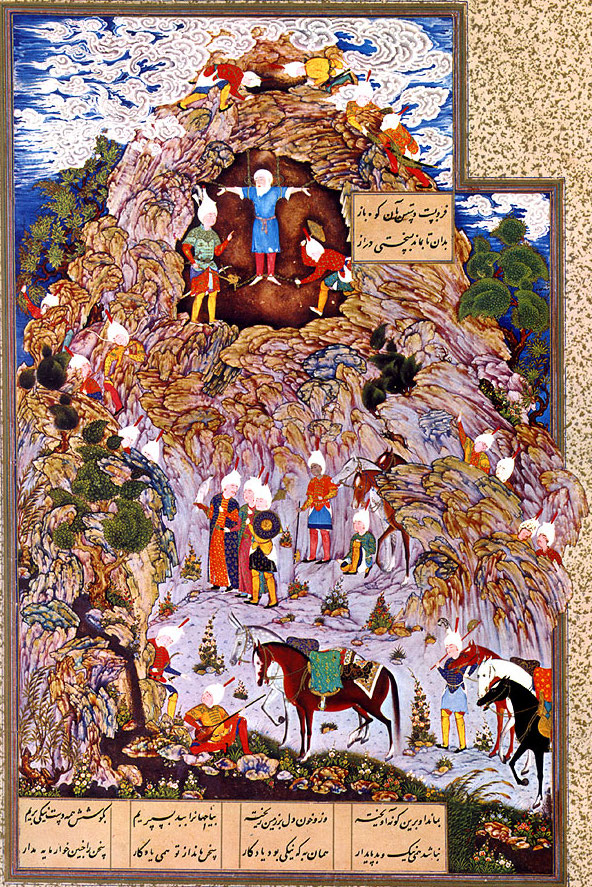Shop Amazon - Create an Amazon Baby Registry

Join Amazon Prime - Watch Thousands of Movies & TV Shows Anytime - Start Free Trial Now
Illustration from the Shahnama of Shah Tahmasp I
f37v: The Death of Zahhak.
Zahhak bound on mount Damavand.
The figures wear early 16th century Persian dress.

click for a modern version of The Death of Zahhak . The Death of Zahhak, early 14th century version . Faridun binds Zahhak, 1544
Faridun vanquished the treacherous Zahhak, nailing him to the walls of a cave in Mount Damavand leaving him to his miserable fate.
164 The death of Zahhak
Attributed to Sultan Muhammad
ca. 1535
Opaque watercolor, gold, and ink on paper
47 x 31.8 cm
AKM 00155
Published: Canby 1998, p. 50; Welch 1976b,
pp. 44 - 47
This painting concludes the cycle of King Zahhak, which is illustrated by a number of scenes. Zahhak gained his throne by making a pact with the devil, Iblis, who brought about the premature death of King Mardas, Zahhak's father. Early in Zahhak's reign, Iblis arrives at the court disguised as a cook. His dishes satisfy Zahhak so much that the king grants his cook anything that he would like. The cook asks if he might kiss Zahhak's shoulders. Two serpents sprout from the spots kissed by Iblis; thereafter, in order to maintain his own life, Zahhak is required daily to feed human brains to the serpents. A tyrannical rule ensues and the only hope for justice rests with Faridun, a hero entrusted in infancy to the cow Birmaya. Despite Zahhak's efforts, Faridun eludes capture, rises up against the king, and overthrows him. "The death of Zahhak" depicts the moment when Zahhak has been brought to Mt. Damavand and is suspended in a cave, per the advice of the angel Surush, where he will suffer until death.
Though one cannot fail to see the primary content - a frail, white-haired Zahhak chained to the walls of the cave, a dark, terrifying hole - the pictorial narrative is treated with a complexity equal to other paintings in Shah Tahmasp's Shahnama. Firdawsi's Shahnama often involves enthronements, battles, and feasting, which yielded a recurring typology in illustrated versions. "The death of Zahhak", a story concerned with the execution of justice and the inauguration of Faridun's enlightened reign, is expanded into a scene of al fresco courtly life, highlighting some of the Iranian ruler's prerogatives. Faridun and his courtiers have dismounted from their horses and explore the landscape, as if taking a pause from hunting. The presence of a musician emphasizes the courtly ambience. The tranquility of the lower half of the painting is contrasted with the upper half, where one finds Zahhak imprisoned in the cave and swirling clouds, some assuming biomor-phic forms as dragons, encircling the bare and rocky mountain. Again, landscape is used not simply as a setting but to heighten the drama of the event.
David J. Roxburgh
pp.216-217, Treasures of the Aga Khan Museum, Masterpieces of Islamic Art
Previous Next
Back to the Shahnama of Shah Tahmasp I


